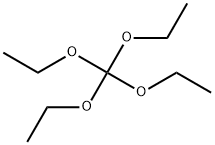Trimethyl orthoacetate
Synonym(s):1,1,1-Trimethoxyethane;1,1,1-Trimethoxyethane, Orthoacetic acid trimethyl ester;Trimethyl orthoacetate
- CAS NO.:1445-45-0
- Empirical Formula: C5H12O3
- Molecular Weight: 120.15
- MDL number: MFCD00008477
- EINECS: 215-892-9
- SAFETY DATA SHEET (SDS)
- Update Date: 2025-04-11 21:28:41

What is Trimethyl orthoacetate?
Chemical properties
CLEAR COLOURLESS TO SLIGHTLY BROWN LIQUID
The Uses of Trimethyl orthoacetate
Trimethyl orthoacetate has been used in the preparation of 2-amino-9-(3-acyloxymethyl-4-alkoxycarbonyloxybut-1-yl)purines and 2-amino-9-(3-alkoxycarbonyl-oxymethyl-4-alkoxycarbonyloxybut -1-yl)purines.
General Description
Kinetics and mechanism of gas-phase elimination of trimethyl orthoacetate has been examined over the temperature range of 310-369°C and pressure range of 50-130Torr.
Properties of Trimethyl orthoacetate
| Boiling point: | 107-109 °C(lit.) |
| Density | 0.944 g/mL at 25 °C(lit.) |
| vapor pressure | 20 hPa (20 °C) |
| refractive index | n |
| Flash point: | 62 °F |
| storage temp. | Store below +30°C. |
| solubility | Chloroform (Sparingly), Methanol (Slightly) |
| form | Liquid |
| color | Clear colorless to slightly brown |
| Specific Gravity | 0.960 (20/4℃) |
| Water Solubility | HYDROLYSIS |
| Sensitive | Moisture Sensitive |
| BRN | 1098338 |
| CAS DataBase Reference | 1445-45-0(CAS DataBase Reference) |
| NIST Chemistry Reference | Ethane, 1,1,1-trimethoxy-(1445-45-0) |
| EPA Substance Registry System | Trimethyl orthoacetate (1445-45-0) |
Safety information for Trimethyl orthoacetate
| Signal word | Danger |
| Pictogram(s) |
 Flame Flammables GHS02  Exclamation Mark Irritant GHS07 |
| GHS Hazard Statements |
H225:Flammable liquids H317:Sensitisation, Skin H319:Serious eye damage/eye irritation |
| Precautionary Statement Codes |
P210:Keep away from heat/sparks/open flames/hot surfaces. — No smoking. P233:Keep container tightly closed. P240:Ground/bond container and receiving equipment. P280:Wear protective gloves/protective clothing/eye protection/face protection. P303+P361+P353:IF ON SKIN (or hair): Remove/Take off Immediately all contaminated clothing. Rinse SKIN with water/shower. P305+P351+P338:IF IN EYES: Rinse cautiously with water for several minutes. Remove contact lenses, if present and easy to do. Continuerinsing. |
Computed Descriptors for Trimethyl orthoacetate
| InChIKey | HDPNBNXLBDFELL-UHFFFAOYSA-N |
Trimethyl orthoacetate manufacturer
JSK Chemicals
3Y
Phone:+91-9879767984
Whatsapp: +91-9879767970
product: 1445-45-0 Trimethyl orthoacetate, 98% 99%
Antares Chem Private Limited
Mumbai
product: Liquid Transparent Trimethyl Orthoacetate For Industrial, Packaging Type: Drum
New Products
Indole Methyl Resin tert-butyl 9-methoxy-3-azaspiro[5.5]undecane-3-carboxylate Boc-His(Boc)-OH 2-CTC Resin 4-Chloro-7-tosy1-7Hpyrrolo[2,3-d]pyrimidine 5,7-Dibromo-1H-indole 2,5-dichloro-N-hydroxy-4,6-dimethylpyridine-3-carboximidamide 2,2-Dimethoxy-7-azaspiro[3.5]nonane hydrochloride 4-chloromethyl-5-methyl-1,3-dioxol-2-one (DMDO-Cl) R-2-BENZYLOXY PROPIONIC ACID 1,1’-CARBONYLDIIMIDAZOLE 1,1’-CARBONYLDI (1,2-4 TRIAZOLE) N-METHYL INDAZOLE-3-CARBOXYLIC ACID 4-((2-hydroxyethyl)thio)benzoic acid 1-(TERT-BUTOXYCARBONYL)-2-PYRROLIDINONE Methyl 6-methylnicotinate 3-Pyridineacrylic acid tert-Butyl carbazate TETRAHYDRO-2H-PYRAN-3-OL 2-((4-morpholinophenylamino) (methylthio) methylene) malononitrile 3-(4-morpholinophenylamino)-5-amino-1H-pyrazole-4-carbonitrile 2,4-dihydroxybenzaldehyde 1,3-Diethyl-1,3-Diphenylurea Methyl 2-methylquinoline-6-carboxylateRelated products of tetrahydrofuran








You may like
-
 Trimethyl orthoacetate 95% CAS 1445-45-0View Details
Trimethyl orthoacetate 95% CAS 1445-45-0View Details
1445-45-0 -
 Trimethyl orthoacetate CAS 1445-45-0View Details
Trimethyl orthoacetate CAS 1445-45-0View Details
1445-45-0 -
 Trimethyl Orthoacetate CASView Details
Trimethyl Orthoacetate CASView Details -
 Trimethyl Orthoacetate CASView Details
Trimethyl Orthoacetate CASView Details -
 Trimethyl Ortho AcetateView Details
Trimethyl Ortho AcetateView Details
1445-45-0 -
 TRIMETHYL ORTHO ACETATE, 50kgView Details
TRIMETHYL ORTHO ACETATE, 50kgView Details
1445-45-0 -
 Trimethyl Orthoacetate ,View Details
Trimethyl Orthoacetate ,View Details
1445-45-0 -
 Liquid Transparent Trimethyl Orthoacetate For Industrial, Packaging Type: DrumView Details
Liquid Transparent Trimethyl Orthoacetate For Industrial, Packaging Type: DrumView Details
1445-45-0
Statement: All products displayed on this website are only used for non medical purposes such as industrial applications or scientific research, and cannot be used for clinical diagnosis or treatment of humans or animals. They are not medicinal or edible.
